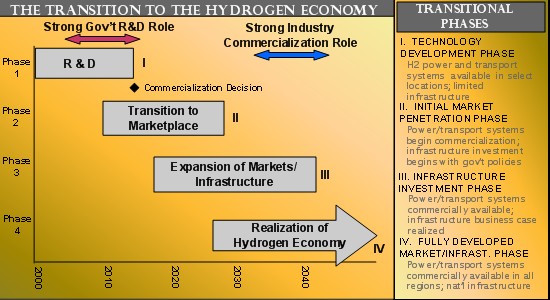|
|
||||||
|
<< September
<< July/August
<< July/August
<< September
<< Nov/Dec 2014
<< June
<< June
<< Part I
(June/July)
<< June
<< June
<< June
<< Part I
(June/July)
* * * |
2005 Essays - August
"GREEN CARS AND THE ROAD AHEAD: A CLEAR FUTURE? -- PART II" *Part II of the "Green Car" series continues with a look at hydrogen as a fuel and fuel cells. Once again it is an interactive essay. Although it can be read as is, links are embedded at various points in the article. By clicking the link you can read more about the particular topic being discussed, then return to the essay. (The links are included for information purposes only. No guarantees are made as to the accuracy of the materials presented on the sites, although every effort has been made to search out reliable and respected sources of information.) (Please note: some links have changed since 2005 or are no longer in existence. Where it is possible, they have be updated to reflect the changes. Changes which have been made are not included in the body of the text but are noted in the "Links List" at the bottom of the page.) Footnotes and a bibliography are also included at the end for anyone wishing to learn more about the subject. The materials represented here are only a small fraction of what is available on this subject matter. A glossary link has been provided as a reference for use as needed. Click here to reach the glossary.*
The potential uses of hydrogen have long been recognized, and hydrogen has been used by NASA "both as a fuel for its rockets and for fuel cells to generate electricity" (n2) for decades. Billions of dollars have been spent over the last ten to fifteen years in pursuit of making hydrogen fuel cell vehicles a reality, part of a move toward what some look to as a future hydrogen-based economy. The efforts underway are not limited to the U.S., however - they are global in scale. From hydrogen-fueled buses in Tokyo and Amsterdam to Iceland's plan for a total hydrogen economy by 2050 (n3) and California's Hydrogen Highway, hydrogen is being viewed as a key to decreasing dependence on foreign energy sources and protecting the global environment. What will be the outcome 40, 50, or even 100 years from now? No one can say with any certainty. In the introduction to Science magazine's 2004 special issue on a hydrogen economy, the authors state that, "two generations down the line, the world may end up with a hydrogen economy completely different from the one it expected to develop. Perhaps the intermediate steps on the road to hydrogen will turn out to be the destination." (n4) Whatever the case, it "is sure to be a long, scientifically engaging journey" (n5). This second and final part of the essay series "Green Cars and the Road Ahead - A Clear Future?" will look in greater depth at hydrogen in transportation and beyond, some of the questions associated with its use, current thoughts on a schedule for moving to a hydrogen economy, both nationally and here in California, and related issues. It is by no means a complete guide to the subject, but rather a collection of information and issues put together as a basic reference for what could be another of the most revolutionary changes of the 21st Century. Timeline for the Transition to a Hydrogen Economy in the U.S. Given the wide-spread efforts currently underway in the United States, it is perhaps useful to have some framework within which to consider how (and when) a move to a hydrogen economy might actually take place. The following chart is taken from 2003 hearings before the Committee on Science of the U.S. House of Representative. (n6) It also appears in several other Department of Energy documents such as the 2004 Hydrogen Posture Plan.
Like any future projection, it is a picture of what the best estimates and current thinking were at the time it was created. Year-to-year technological and other advances may come to alter the dates and details as they exist. For example, advances in the field of automotive fuel cell development are moving rapidly. Some automobile manufacturers may have commercially available fuel cell vehicles well in advance of the 2015 estimated date for decisions on hydrogen commercialization. On the other hand, a complete transition to a hydrogen economy might be more difficult or more complicated to implement than originally projected. This could push the date for full transition past mid-century or later. Still, it is a valuable illustration for thinking about what might happen in your lifetime or those of your children and grandchildren. In Part I of the essays (July), some of the benefits of hydrogen and fuel cells were discussed. Though hydrogen has been used and produced in segments of the oil refining and other industries for years, its use in transportation has been virtually non existent. There are special problems posed not only by the production, distribution and storage of hydrogen, but also by an existing petroleum-based fuel infrastructure which is largely incompatible with the delivery of hydrogen. Each of these problems will be examined briefly in the next section. Hydrogen Production As stated in Part I, hydrogen is not a primary energy source. It must be produced (like electricity) using some other renewable or non-renewable energy resource in order to be used as a fuel. Two of the most common methods of production are called steam reformation (using natural gas) and electrolysis. "Most hydrogen [today] is produced by steam reformation of methane . . . a process [which also] releases carbon dioxide, an air pollutant." (n7) The production of hydrogen by electrolysis, a process in which an electrical current is run through water separating it into hydrogen and oxygen, can be done using non-polluting, renewable resources such as solar power. Hydrogen can also be generated in processes involving renewable energy sources such as wind farms, biomass systems [or] nuclear power plants. (n8) Each of the production systems has its own benefits and drawbacks. Although steam reformation produces the pollutant carbon dioxide, processes like it using hydrocarbon-based fuel sources (such as natural gas) are "more cost competitive with today's fuels." (n9) Wind and solar energy may be used successfully in certain instances, but each also has limitations. For example, "economist Andrew Oswald of the University of Warwick in England calculates that converting every vehicle in the U.S. to hydrogen power would require the electricity output of a million wind turbines - enough to cover half of California . . . [Also,] according to a study done by the World Resources Institute . . . fueling a hydrogen economy with electrolysis would require 4.2 trillion gallons of water annually -- roughly the amount that flows over Niagara Falls every three months. Overall U.S. water consumption would increase by 10 percent." (n10) Looking at the near term, "it is likely that hydrogen will be produced by steam reforming and electrolysis. In the mid- to long-term, the hydrogen production technologies currently under development (renewables, high temperature nuclear chemical cycles, and clean coal and natural gas) will become more cost effective and contribute to a diversification" (n11) of hydrogen production in the U.S. Hydrogen Transportation and Storage Most of today's liquid fuels are easily handled at room temperature. However, "because hydrogen is the lightest element, far less of it can fit into a given volume than other fuels. At room temperature and pressure, hydrogen takes up roughly 3000 times as much space as gasoline containing the same amount of energy." (n12) As a result, this presents challenges not only in the transportation of hydrogen but also in the on-board storage for use in a hydrogen fuel cell. Hydrogen must be stored either "as a compressed gas (in high-pressure cylinders), as a very low temperature or cryogenic liquid at -235 degrees C (in a special insulated vessel), or in a hydrogen compound where the hydrogen is easily removed by applying heat." (n13) This has been a particular challenge for automobile manufacturers, since "tanks pressurized to 10,000 lbs. per square inch take up to eight times the volume of a current gas tank to store the same amount of fuel." (n14) Great strides have been made in fuel cell prototypes, but of all the prototypes on the road, none appears able as of yet to reach the common industry benchmark of 300 miles per tank of fuel. For example, take the experimental hydrogen-powered Hummer regularly demonstrated by California's Governor Arnold Schwarzenegger. A 2004 spec card lists the fuel storage capacity as three carbon fiber composite tanks carrying a total of 12 pounds of hydrogen with a total range of about 60 miles. (n15) Honda's prototype hydrogen FCX, its fifth version of the car, fares better with a range of about 130 - 190 miles on a 3.75 kilogram capacity tank. (n16) Still, reaching the 300 mile benchmark will be a significant milestone in the move toward commercially comparable hydrogen-powered fuel cell vehicles.
Photograph "Moorea, Tahiti" © 1983 Dorothy A. Birsic Hydrogen in a Petroleum Infrastructure It is easy to take for granted the existing petroleum infrastructure that allows a person to fill a car with gasoline just about anywhere at almost any time. Given that hydrogen may compete with gasoline as a fuel source, especially in the early years of a transition to a full-fledged hydrogen economy, "it faces an established infrastructure of 161 oil refineries, 2000 oil storage terminals, roughly 220,000 miles of crude oil and oil products lines, and more than 175,000 gasoline service stations." (n17). Since the equipment and fueling systems are different for hydrogen than for gasoline, "much of the infrastructure would have to be replaced or heavily modified if hydrogen is to become the dominant fuel for the highway transportation sectors." (n18) The costs of conversion could be enormous from both a government and industry perspective. One fuel company, BP, estimates that "given a modification cost of about $400,000 per site, the cost to them alone to modify all of their U.S. retail [locations] would be about $6.8 billion." (n19) The State of California has taken a proactive approach to the issue of establishing a statewide hydrogen infrastructure. Last year Governor Arnold Schwarzenegger announced his vision for a network of hydrogen fueling stations along the state's major highways. In April of 2004 he signed an executive order creating the California Hydrogen Highway Network Initiative, the blueprint of which sets forth an agenda for building a hydrogen infrastructure for California. The stated goal of the Network Initiative (available in its entirety at www.hydrogenhighway.ca.gov) is "to support and catalyze a rapid transition to a clean hydrogen transportation economy in California." (n20) As with the national plan, it will be implemented in phases targeting both the number of hydrogen refueling facilities to be established and a target number of hydrogen-powered vehicles to be served. Currently there are 16 working hydrogen stations in the state with 15 more planned, and a total of 95 fuel cell vehicles in operation. A map with a complete listing of the sites is available at the California Fuel Cell Partnership website, www.cafcp.org/fuel-vehl_map.html. The South Coast Air Quality Management District (AQMD) is also playing an active role in creating a hydrogen fueling network in Southern California. The organization is assisting in establishing fueling stations that "will demonstrate [hydrogen] electrolyzers, various types of reformers, bulk deliveries of hydrogen by truck, pipeline or transportable fuelers, direct solar and high-temperature plasma hydrogen production, as well as the use of renewable power to generate hydrogen and operate fueling sites. Lessons learned from these projects will be used to develop plans for the efficient, convenient, cost-effective hydrogen stations of the future." (n21)
Power Generation and Carbon Sequestration As stated in Part I, the dual goals of "environmental quality, especially the reduction of greenhouse gas emissions, and energy security provide the public policy foundations for hydrogen programs" (n22) in the United States. So far both sections of the essay have focused primarily on hydrogen and transportation. Globally, the transportation sector "accounts for roughly one third of current carbon emissions and is expected to pose even larger threats with the rapid expansion of the transportation sector in large developing countries" (n23) such as China. No discussion would be complete, however without at least a brief look at the other main source of carbon emissions, power generation. In the U.S., the two sectors that are the primary sources of "energy-related carbon [emissions] are those involving 1) the burning of coal to produce electricity, and 2) the burning of petroleum in transportation fuels. Any hydrogen-based energy systems must address [both] these sectors in order to achieve the full environmental benefits of hydrogen energy." (n24). There are basically two ways of addressing the problems associated with carbon emissions from power generation (including possible future emissions from hydrogen generation): "rerouting" the emissions or developing cleaner (or emission-free) power plants. Both options are currently being explored. By varying accounts, anywhere from 3 - 4 gigatons (n25) to 6.5 gigatons (n26) of carbon accumulate in the atmosphere each year from the burning of fossil fuels. In order to limit the amount of CO2 released into the atmosphere, "many scientists have argued for capturing a sizable fraction of that CO2 from electric plants, chemical factories and the like and pumping it deep underground," (n27) a process referred to as carbon sequestration. Carbon sequestration has its roots in the oil industry in a common practice called enhanced oil recovery, a method of "flooding depleted or high viscosity oil fields [with CO2 so that the] CO2 and oil mix to form a liquid that easily flows to the surface." (n28) It is now thought to be possible to sequester carbon emissions deep underground in depleted oil and natural gas fields, and it is estimated that such depleted fields could hold as much as "130 gigatons of carbon worldwide." (n29) One of the largest projects testing the feasibility of carbon sequestration is currently underway in Canada and is known as the Weyburn Project. "To date, nearly 3.5 million metric tons of CO2 have been locked away in the Weyburn reservoir . . . with no evidence of significant amounts of injected CO2 coming out at the surface." (n30) For more information on the Weyburn Project and carbon sequestration in general, visit www.co2captureandstorage.info. In Feburary of 2003, President Bush also announced "a $1 billion project to build an emission-free power plant. This project, named FutureGen, seeks to build a prototype plant that will establish the technical and economic feasibility of producing electricity and hydrogen from coal while capturing and sequestering the CO2 generated in the process." (n31) A first demonstration plant is expected in 2007, and larger-scale demonstrations are expected to start in 2012. (n32) Further information on FutureGen can be found at www.netl.doe.gov/coalpower/sequestration/futureGen/main.html.
Photograph © 2011 Dorothy A. Birsic Fuel Cells and Distributed Power Generation Although in the distant future, fuel cells in automobiles may one day bridge the gap between transportation and electricity generation through a "revolution in the garage." (n33) Since fuel cells "generate waste heat as well as electricity, . . . [the] waste heat can be captured and put to use." (n34) Eventually homes/garages may be equipped to convert this waste heat and direct it toward "space heating, water heating, steam generation and even air conditioning." (n35). Although a more detailed explanation will be beyond the scope of this essay, it is estimated that "a typical midsize fuel cell vehicle [c]ould produce 50 to 75 kilowatts of power, where a typical household may use 7 to 10 kilowatts at peak load." (n36) This is just one of the many potential applications of fuel cells which may emerge in the years to come. The Reality of a Hydrogen Economy "Identifying and building a sustainable energy system are perhaps two of the most critical issues that today's society must address. Replacing our current energy carrier mix with a sustainable fuel is one of the key pieces in that system . . . Future energy systems require money and energy to build. Given that the United States has a finite supply of both, hard decisions must be made about the path forward, and this path must be followed with a sustained and focused effort." (n37) According to the National Research Council 2004 report, The Hydrogen Economy: Opportunities, Costs, Barriers and R&D Needs, the answers to four pivotal questions will largely determine when - and whether - the hydrogen economy will become a reality. Those questions, and the issues they address, are:
* * * Thank you for visiting this month's essay at www.dorothyswebsite.org. Please come back in September for the next issue and a new topic in the summer essay series! FOOTNOTES - The following are the footnotes indicated in the text in parentheses with the letter "n" and a number. If you click the asterisk at the end of the footnote, it will take you back to the paragraph where you left off. n1 - United States Department of Energy, "H Facts" Fact Sheet Series: The History of Hydrogen, Washington D.C.: U.S. Department of Energy (undated), p. 1. Available at www.eere.energy.gov/hydrogenandfuelcells/. (*) n3 - Vogel, Gretchen, "Will the Future Dawn in the North?" Science, Vol. 305, 13 August 2004, p. 966 (*) n4 - Coontz, Robert and Hanson, Brooks, "Not So Simple," Science, Vol. 305, 13 August 2004, p. 957 (*) n6 - A Path to a Hydrogen Economy, Hearings, Committee on Science, United States House of Representatives, 108th Congress, 1st Session, Serial No. 108-4, March 5, 2003, p. 24 (*) n7 - Rivkin, Carl H. "Hydrogen and the New Energy Infrastructure," NFPA Journal, Vol. 99, No. 3, May/June 2005, p. 61 (*) n9 - The Hydrogen Energy Economy, Hearings, Subcommittee on Energy and Air Quality, Committee on Energy and Commerce, U.S. House of Representatives, 108th Congress, 1st Session, Serial No. 108-21, May 20, 2003, p. 63 (*) n10 - Behar, Michael, "Warning: The Hydrogen Economy May Be More Distant Than It Appears," Popular Science, Vol., No., January 2005, p. 66 (*) n11 - United States Department of Energy, "H Facts" Fact Sheet Series: The Hydrogen Economy, Washington D.C.: U.S. Department of Energy (undated), p. 1. Available at www.eere.energy.gov/hydrogenandfuelcells (*) n12 - Service, Robert F., "The Hydrogen Backlash," Science, Vol. 305, 13 August 2004, p. 960 (*) n13 - A Path to a Hydrogen Economy, p. 54 (*) n15 - General Motors Corporation, Hummer H2H Specifications and Performance Data card ("School is in. And it Starts with Science Class), 2004 (*) n16 - Vanderwerp, Dave, "Honda Proves it's Ready for a Hydrogen Economy. Now Where's the Hydrogen?" Car and Driver, Vol. 51, No. 1, July 2005, pp. 77, 80 and 81 (*) n17 - National Research Council, The Hydrogen Economy: Opportunities, Costs, Barriers and R&D Needs, Washington D.C., National Academies Press, 2004, p. 19 (*) n19 - Uihlein, James P., testimony in Fuel Cells: The Key to Energy Independence?, Field Hearing, Subcommittee on Energy, Committee on Science, U.S. House of Representatives, 107th Congress, 2nd Session, Serial No. 107-83, June 24, 2002, p. 17 (*) n20 - Introduction to Hydrogen Highway website, www.hydrogenhighway.ca.gov, last accessed August 8, 2005 (*) n21 - Dixon, Gary, "Progress in Developing [a] Hydrogen Fueling Infrastructure and Hydrogen-Fueled Vehicle Demonstrations in the South Coast Air Quality Management District," paper from Hydrogen: A Clean Energy Source. Conference Proceedings, National Hydrogen Association, 15th Annual U.S. Hydrogen Conference and Hydrogen Expo USA, April 26 - 30, 2004, Conference CD-ROM, p. 11 of 11 (*) n22 - National Research Council, p. 14 (*) n23 - Kobayashi, Hayato, "Climate Change and Future Options for Carbon Sequestration," Foresight: The Journal of Futures Studies, Strategic Thinking and Policy, Vol. 6, No. 3, 2004, p. 159 (*) n24 - National Research Council, p. 15 (*) n25 - United Stated Department of Energy, Office of Fossil Energy, National Energy Technology Laboratory (NETL), "Program Facts: Sequestration," Carbon Sequestration Through Enhanced Oil Recovery (Factsheet), Washington D.C., NETL, August 2003, p. 2 (*) n26 - Service, Robert F., "The Carbon Conundrum," Science, Vol. 305, 13 August 2004, p. 962 (*) n28 - U.S. Department of Energy, NETL, p. 1 (*) n30 - Service, "Carbon Conundrum," p. 963 (*) n33 - Evers, A. A., "Fueling Our Future: Setting the State for the Coming Hydrogen Economy," paper from Hydrogen: A Clean Energy Source. Conference Proceedings, National Hydrogen Association, 15th Annual U.S. Hydrogen Conference and Hydrogen Expo USA, April 26 - 30, 2004, Conference CD-ROM, p. 3 of 5 (*) n34 - "Distributed Generation in Our Future," National Fuel Cell Research Center (NFCRC) Journal, Vol. 4, No. 1, Winter 2003, p. 2 (*) n36 - The Hydrogen Energy Economy (Hearings), p. 43 (*) n37 - Turner, John A., "Sustainable Hydrogen Production," Science, Vol. 305, 13 August 2004, p. 972 (*) n38 - National Research Council, p. 23 (*) LINKS INCLUDED IN ESSAY
Click here to go to the combined bibliography for parts I and II of the "Green Cars" essays. To return to the top of the page, click here. To return to the essay archives, click here.
Follow www.dorothyswebsite.org on TWITTER! Home |
Essays | Poetry | Free Concerts | Links | 2019 Extras |
About the Site |
|||||
|
www.dorothyswebsite.org © 2003 - 2019 Dorothy A. Birsic. All rights reserved. Comments? Questions? Send an e-mail to: information@dorothyswebsite.org | ||||||











